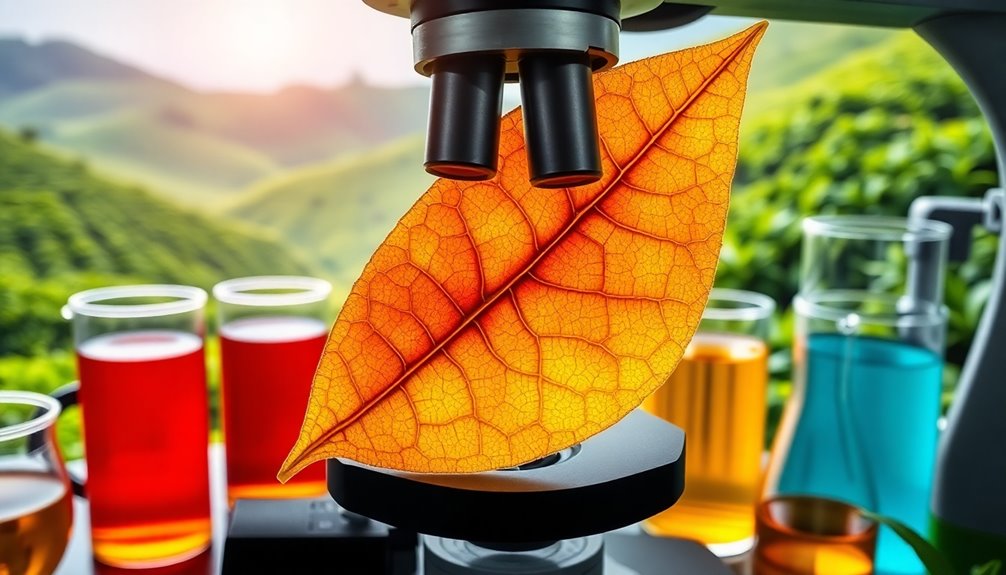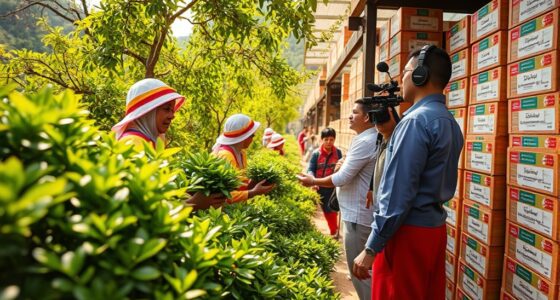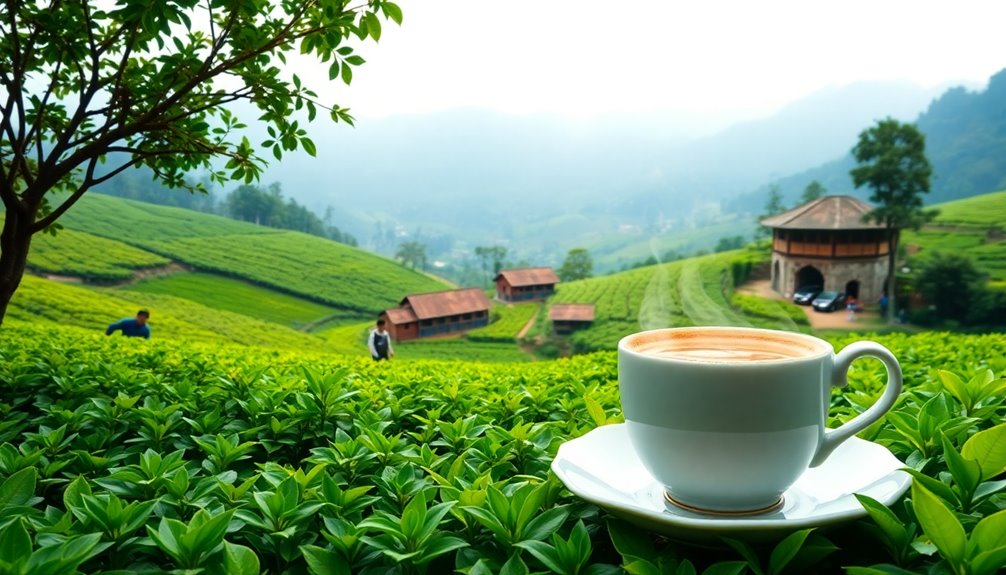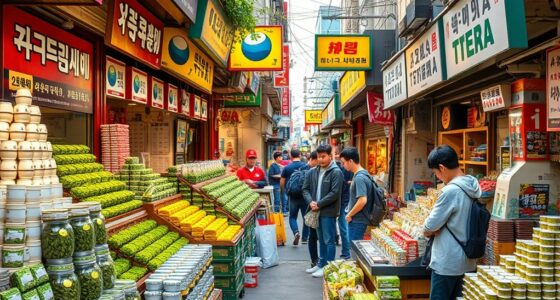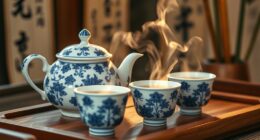Breaking news in tea science highlights some incredible discoveries you won't want to miss. Recent studies show that drinking tea, particularly oolong, can help manage diabetes and improve gut health. New measurement methods have enhanced our understanding of tea's antioxidant capacity. Additionally, researchers have found that tea plants' natural defenses against pests can be optimized by timing, which promises greener production methods. With climate change impacting tea quality, sustainable practices are crucial for the future. There's much more to uncover about these fascinating developments, so keep an eye out for the full scoop on tea science!
Key Takeaways
- Recent studies highlight tea's potential in managing diabetes, with compounds enhancing glucose metabolism and reducing the risk of type 2 diabetes.
- Novel methods for measuring antioxidant capacity in tea have been developed, improving accuracy and increasing consumer awareness of health benefits.
- Ongoing research shows that oolong tea's polyphenols not only aid gut health but also reduce inflammation, potentially combating cognitive decline.
- Genetic advancements are enhancing tea plants' resistance to drought and diseases, promoting sustainable tea production amid climate change challenges.
- Circadian rhythms in tea plants have been found to enhance pest defense, optimizing the timing of their natural protective responses against threats.
Introduction
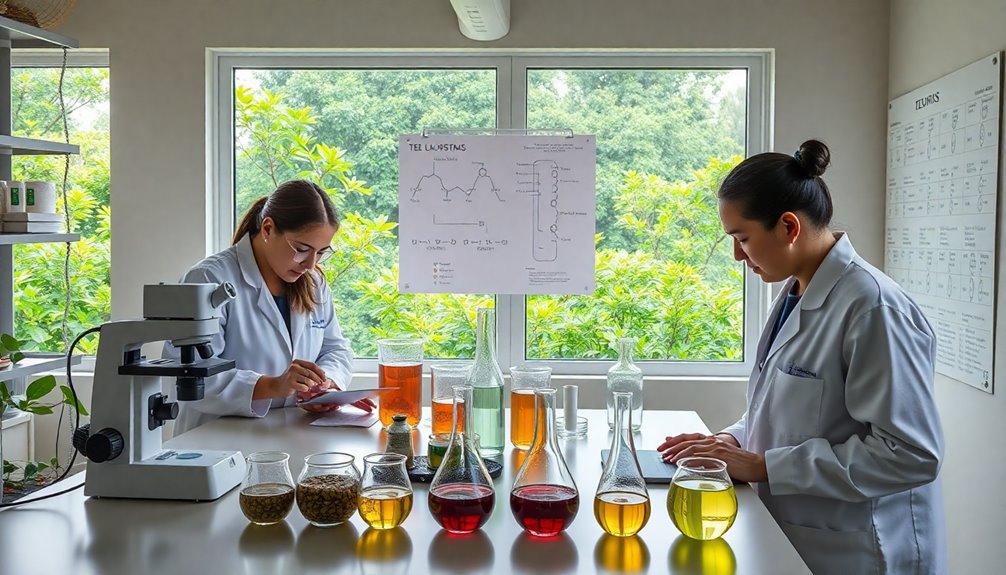
Tea science has made significant strides in recent years, uncovering fascinating insights about the health benefits and biochemical properties of this beloved beverage. One of the most exciting areas of research focuses on the potential of tea, particularly Camellia sinensis, as a natural alternative for managing various health conditions, including diabetes. The active compounds in tea work synergistically with other natural substances to enhance these benefits.
Moreover, studies reveal that oolong tea polyphenols can alleviate cognitive decline. They achieve this by reducing inflammation and regulating gut microbiota, which indicates their protective effects on cognitive health. This connection between tea consumption and improved brain function highlights its role as a valuable addition to your daily routine.
As researchers continue to explore tea's biochemical properties, they're uncovering more evidence supporting its health benefits. From diabetes management to cognitive health, tea offers a multitude of advantages that can enhance your overall well-being.
Embracing tea as part of your lifestyle could be a simple yet effective way to support your health and mitigate risks associated with cognitive decline.
Tea's Antioxidant Capacity Advancements

Recent advancements in tea's antioxidant capacity are revolutionizing how we evaluate its health benefits. A new study introduces a novel analytical method that measures the antioxidant capacity of tea plants by utilizing DPPH radical consumption. This method showcases excellent linearity, precision, and stability, allowing for more accurate assessments of tea's health-promoting properties.
Incorporating CO laser technology and a 3D-printed cell, this innovative approach creates laser-induced graphene (LIG) electrodes that enhance measurement accuracy. The results from this technique align closely with traditional UV-visible spectrophotometry, confirming its reliability for evaluating antioxidant levels in various teas.
What's exciting is that this advancement promises quicker evaluations, benefiting both researchers and consumers alike. With more precise data on antioxidant capacity, you can better understand how different tea varieties contribute to your health.
As these new methods gain traction, the ongoing efforts to quantify tea's health benefits will likely lead to increased consumer awareness and interest in the specific varieties that offer the highest antioxidant potential. This is an exhilarating time for tea science, and you're at the forefront of discovering how these advancements can enhance your tea-drinking experience.
Antidiabetic Properties of Tea
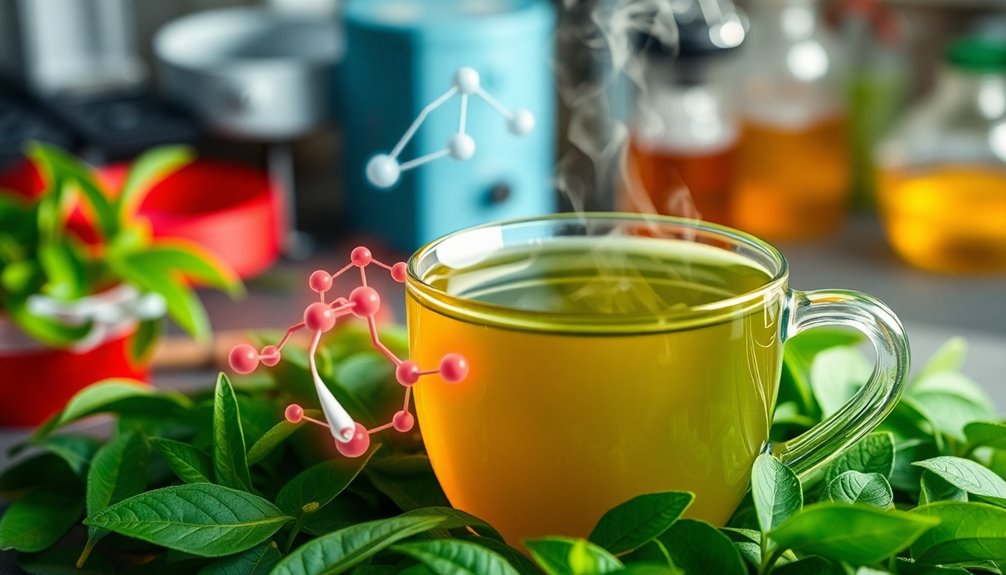
Research has consistently shown that the benefits of tea extend beyond its antioxidant capacity, particularly in managing diabetes. Recent studies highlight the antidiabetic properties of tea, especially from Camellia sinensis, which may serve as a natural alternative for diabetes management. The active compounds in tea enhance glucose metabolism, making it a potential ally for those looking to control their blood sugar levels.
Oolong tea stands out due to its rich polyphenol content, which not only reduces inflammation but also improves gut health. A healthy gut microbiota is crucial for maintaining balanced blood sugar levels, and oolong tea seems to support this balance effectively.
Clinical trials have even linked regular tea consumption to a reduced risk of developing type 2 diabetes, showcasing its protective effects.
Moreover, the synergistic effects of tea compounds combined with other natural substances are being explored, possibly increasing their antidiabetic efficacy compared to conventional medications. Ongoing investigations aim to uncover how tea affects glucose absorption and insulin sensitivity, revealing promising results that could revolutionize diabetes management.
Circadian Rhythms Influence Pest Defense
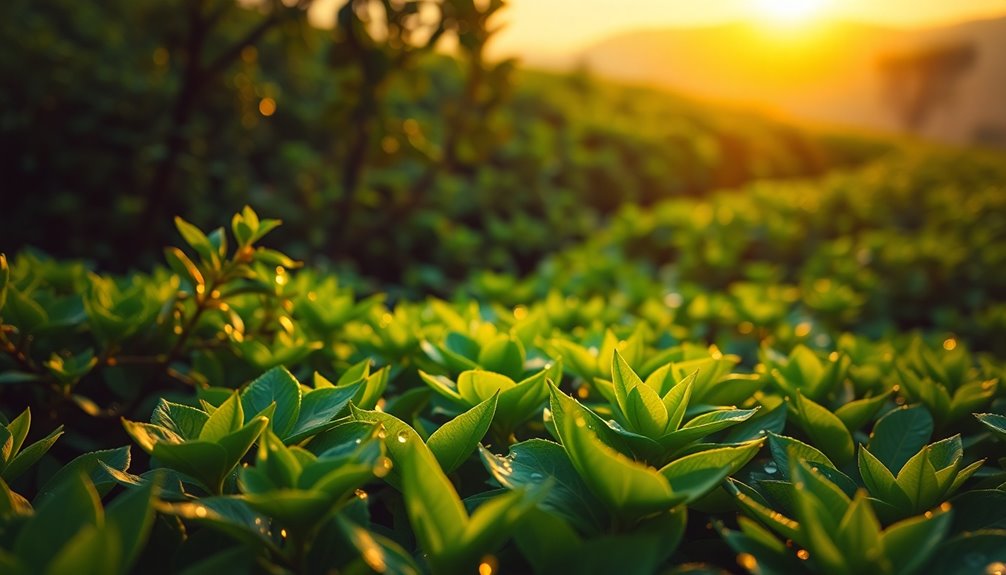
Circadian rhythms play a crucial role in how tea plants defend themselves against pests. Recent research reveals that these rhythms enable tea plants to boost their pest defense mechanisms through the production of benzyl nitrile, a compound that effectively deters herbivores. The gene CsPCL1 is integral to this process, as it activates the biosynthesis of benzyl nitrile, enhancing the plant's defensive responses.
Moreover, the activation of the jasmonic acid signaling pathway, influenced by circadian rhythms, further amplifies the plant's ability to respond to pest threats. This means that the timing of these defensive actions is finely tuned, ensuring optimal protection when pests are most active.
Experimental application of slow-release benzyl nitrile beads in tea cultivation has shown impressive results, leading to a significant reduction in pest populations. This indicates a promising, eco-friendly pest control strategy that aligns with the natural rhythms of tea plants.
Sustainability in Tea Production
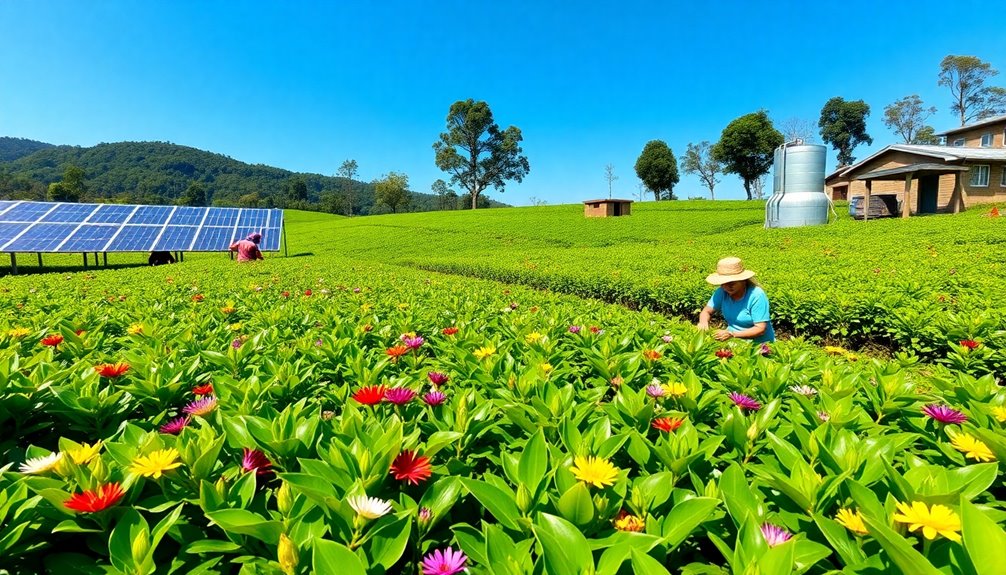
Sustainability in tea production is essential for ensuring the future of this beloved beverage in the face of climate change. The global tea industry faces significant challenges due to climate change, affecting both the quantity and quality of tea yields. You can contribute to sustainability by supporting practices that enhance plant growth and drought resistance.
The Tea-CUP project is working to provide climate services tailored specifically for the tea sector, addressing the increased weather variability that threatens tea cultivation. Genetic research is also a crucial factor; scientists are enhancing drought and disease resistance in tea plants to ensure robust yields even under stress.
Moreover, innovative practices like using Arbuscular Mycorrhizal Fungi (AMF) can significantly improve tea plant growth and resilience during drought conditions.
By understanding the biochemical pathways and environmental impacts of tea cultivation, you can help maintain the quality and sustainability of tea production.
Together, these efforts promote a more resilient tea industry, ensuring that future generations can continue to enjoy this treasured beverage while minimizing environmental impact. Embracing sustainable practices is a win-win for both tea lovers and the planet.
Practical Applications
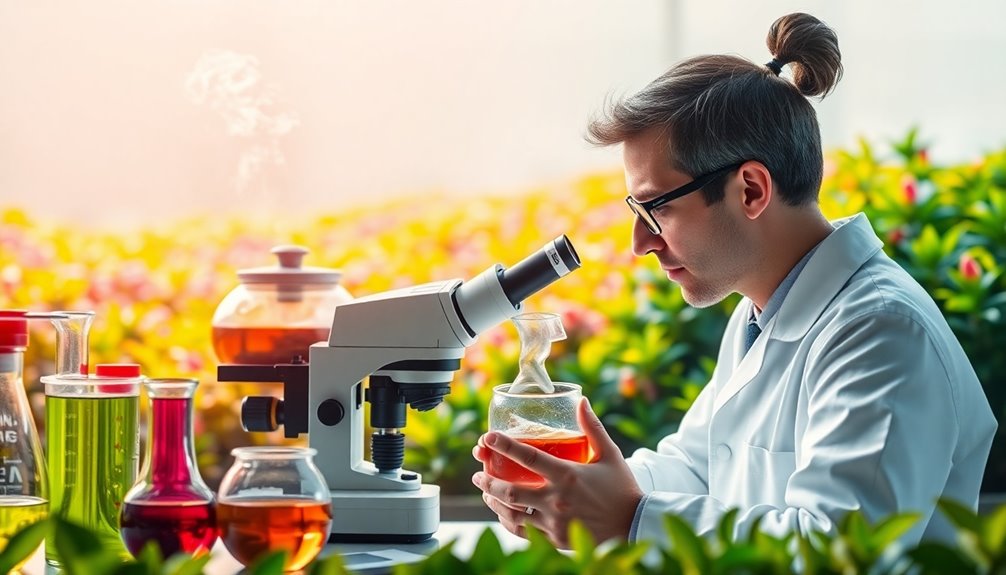
Building on the importance of sustainable practices in tea production, practical applications of recent scientific discoveries can significantly enhance both the quality and health benefits of tea.
For instance, a novel analytical method using DPPH radical consumption and laser-induced graphene electrodes allows you to quickly and accurately evaluate the antioxidant capacity of different teas. This study reveals that by selecting teas with higher antioxidant levels, you can improve your overall health.
Additionally, research highlights the benefits of Oolong tea polyphenols in alleviating cognitive decline by reducing inflammation. Incorporating these teas into your diet could be a simple way to support cognitive health.
Moreover, the discovery of purified tea polysaccharide (TPS3A) shows promise in improving kidney function and slowing the progression of kidney disease. This presents a practical opportunity for those looking to enhance their health through food-derived therapeutic agents.
Conclusion
In conclusion, the latest discoveries in tea science reveal exciting advancements that could transform our understanding and enjoyment of this beloved beverage. From its powerful antioxidants and potential antidiabetic benefits to the fascinating ways it interacts with circadian rhythms and sustainable production methods, tea is more than just a drink; it's a source of health and innovation. As you explore these findings, you're not just sipping tea—you're participating in a growing movement towards healthier living and sustainable practices.

